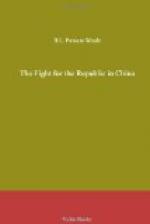Meanwhile wholesale executions were carried out in the provinces with monotonous regularity and all attempts at rising ruthlessly suppressed. In Peking the infamous Chih Fa Chu or Military Court— a sort of Chinese Star-Chamber—was continually engaged in summarily dispatching men suspected of conspiring against the Dictator. Even the printed word was looked upon as seditious, an unfortunate native editor being actually flogged to death in Hankow for telling the truth about conditions in the riverine districts. These cruelties made men more and more determined to pay off the score the very first moment that was possible. Although he was increasingly pressed for ready money, Yuan Shih-kai, by the end of April, 1914, had the situation sufficiently in hand to bring out his supreme surprise,—a brand-new Constitution promulgated under the euphonious title of “The Constitutional Compact.”
This precious document, which had no more legality behind it as a governing instrument than a private letter, can be studied by the curious in the appendix where it is given in full: here it is sufficient to say that no such hocuspocus had ever been previously indulged in China. Drafted by an American legal adviser, Dr. Goodnow, who was later to earn unenviable international notoriety as the endorser of the monarchy scheme, it erected what it was pleased to call the Presidential System; that is, it placed all power directly in the hands of the President, giving him a single Secretary of State after the American model and reducing Cabinet Ministers to mere Department Chiefs who received their instructions from the State Department but had no real voice in the actual government. A new provincial system was likewise invented for the provinces, the Tutuhs or Governors of the Revolutionary period being turned into Chiang Chun or Military Officials on the Manchu model and provincial control absolutely centralized in their hands, whilst the Provincial Assemblies established under the former dynasty were summarily abolished. The worship at the Temple of Heaven was also re-established and so was the official worship of Confucius—both Imperialistic measures— whilst a brand-new ceremony, the worship of the two titulary Military Gods, was ordered so as to inculcate military virtue! It was laid down that in the worship of Heaven the President would wear the robes of the Dukes of the Chow dynasty, B. C. 1112, a novel and interesting republican experiment. Excerpts from two Mandates which belong to these days throw a flood of light on the kind of reasoning which was held to justify these developments. The first declares:




